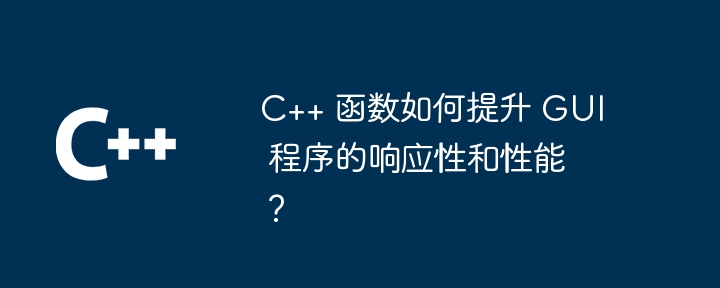Home >Backend Development >C++ >How can C++ functions improve the responsiveness and performance of GUI programs?
How can C++ functions improve the responsiveness and performance of GUI programs?
- WBOYWBOYWBOYWBOYWBOYWBOYWBOYWBOYWBOYWBOYWBOYWBOYWBOriginal
- 2024-04-25 14:27:02978browse
C functions can be used to improve GUI program responsiveness and performance, including: QThread::msleep(): sleep the program to allow other threads to execute. QTimer::singleShot(): Delay or asynchronously execute tasks to reduce the load on the main thread. QEventLoop::processEvents(): Process events to avoid GUI freezing. std::thread: Create and manage independent threads to improve overall performance.

C function improves GUI program responsiveness and performance
In graphical user interface (GUI) programs, responsiveness is crucial important. In order to improve the responsiveness of the GUI program, we can use the following functions provided by C:
1. QThread::msleep()
msleep() function makes the program sleep Specify the number of milliseconds to allow other threads to execute. This is useful for performing computationally intensive operations or preventing the GUI from freezing.
Example:
// 休眠 1000 毫秒 QThread::msleep(1000);
2. QTimer::singleShot()
singleShot() function after the specified time interval Dispatches a one-time timer event. It can be used to delay or asynchronously execute tasks, thereby offloading the main thread.
Example:
// 在 1 秒后调用 update() 方法 QTimer::singleShot(1000, this, SLOT(update()));
3. QEventLoop::processEvents()
processEvents() function handles pending events , allowing other threads to process input and update the GUI. This is useful to avoid GUI freezing.
Example:
// 处理待处理的事件 QEventLoop().processEvents();
4. std::thread
std::thread allows the creation and management of independent threads. Multithreading helps spread compute-intensive tasks across multiple CPU cores, thereby improving overall performance.
Example:
// 创建一个新线程
std::thread t([]() { doSomething(); });Practical case
Suppose we have a GUI program that processes large amounts of data. To improve its responsiveness, we can use the QThread::msleep() function to sleep computationally intensive operations. Additionally, we can use the QTimer::singleShot() function to delay updating the GUI until the operation is complete. With the above techniques, we can significantly improve the responsiveness of the program without affecting its other functionality.
Using these C functions, we can develop responsive and high-performance GUI programs to provide users with a smooth and pleasant experience.
The above is the detailed content of How can C++ functions improve the responsiveness and performance of GUI programs?. For more information, please follow other related articles on the PHP Chinese website!

